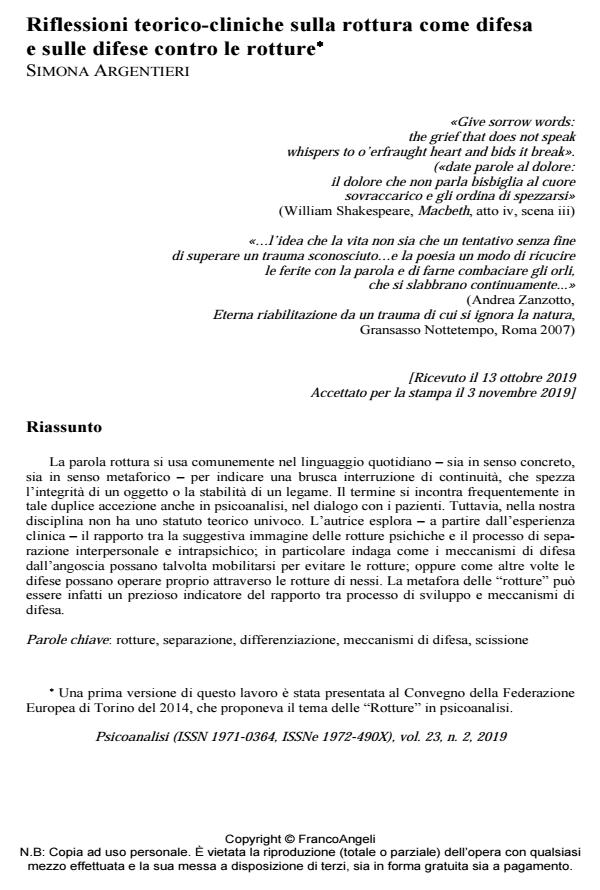Theoretical-clinical Reflections on the Rapture as a Defense and on the Defences against the Rapture
Journal title PSICOANALISI
Author/s Simona Argentieri
Publishing Year 2020 Issue 2019/2 Language Italian
Pages 15 P. 27-41 File size 179 KB
DOI 10.3280/PSI2019-002003
DOI is like a bar code for intellectual property: to have more infomation
click here
Below, you can see the article first page
If you want to buy this article in PDF format, you can do it, following the instructions to buy download credits

FrancoAngeli is member of Publishers International Linking Association, Inc (PILA), a not-for-profit association which run the CrossRef service enabling links to and from online scholarly content.
The word rupture is commonly used in everyday language - both in a concrete sense and in a metaphorical sense - to indicate a sudden interruption of continuity, which breaks the in-tegrity of an object or the stability of a bond. The term is frequently encountered in this double meaning also in psychoanalysis, in dialogue with patients. However, in our discipline it does not have a univocal theoretical status. The author explores - starting from the clinical experi-ence - the relationship between the suggestive image of the psychic rapture and the process of inter-personal and intrapsychic separation; it investigates how the defense mechanisms against anxiety can sometimes be used to avoid raptures; or like, other times, the defenses can work right through the raptures of connections. The metaphor of "Raptures" can indeed be a valua-ble indicator of the relationship between the development process and defense mechanisms.
Keywords: Rapture, separation, differentiation, defense mechanisms, splitting
- Argentieri S. (2006). Meccanismi di difesa e livelli precoci. Psicoanalisi, 10, 1.
- Argentieri S. (2006). Travestitismo, transessualismo, transgender: identificazione e imitazione. Psicoanalisi, 10, 2: 55-92.
- Argentieri S. (2008). L’ambiguità. Torino: Einaudi.
- Amati J., Argentieri S., Canestri J. (1990). La Babele dell’inconscio. Lingua madre e lingue straniere nella dimensione piscoanalitica. Cap. 12, § 1, Scissione e integrazione. Milano: Raffaello Cortina.
- Argentieri S. (1999). Il padre materno-da San Giuseppe ai nuovi mammi. Roma: Meltemi.
- Argentieri S. (2003). L’incesto ieri e oggi. Dal conflitto all’ambiguità. Psicoanalisi, 7, 2: 101-131.
- Argentieri S. (2004). Perversioni o parafilie? Dal disagio della civiltà alla patologia del benessere. Gli Argonauti, 7: 9-20.
- Argentieri S. (2009). All’origine del pensiero: immagini, allucinazioni primarie, percezioni endopsichiche, protofantasie. In: Di Giacomo G. (a cura di), Ripensare le immagini. Milano: Mimesis.
- Argentieri S. (2013). La lacrima di Narciso. In: Rossi Monti, M., Gosio, N. (a cura di), Depressione: il paradigma errante. La nuova clinica fra scienza e cultura. Milano: Franco Angeli.
- Argentieri S. (2014). Il padre materno. Torino: Einaudi.
- Baranger M. (1959). Mala fé’, identidad y omnipotencia. In: Baranger W., Baranger M., Problemas del campo psicoanalitico. Buenos Aires: Kargieman.
- Bleger J. (1967). Simbiosis y Ambigüedad. Buenos Aires: Paidós.
- Freud A. (1936). The Ego and the Mechanism of Defence. London, Karnac Book, 1992. (trad. it.: L’io e i meccanismi di difesa. In: Opere 1922-1943, vol. 1. Torino: Bollati Boringhieri, 1978).
- Freud S. (1913). Totem e tabù. In: Opere, vol. 7. Torino: Bollati Boringhieri, 1975.
- Freud S. (1915). L’inconscio. In: Opere, vol. 8. Torino: Bollati Boringhieri, 1975.
- Freud S. (1915). Lutto e melanconia. In: Opere, vol. 8. Torino: Bollati Boringhieri, 1975.
- Freud S. (1938). La scissione dell’Io nel processo di difesa. In: Opere, vol. 11. Torino: Bollati Boringhieri, 1979.
- Gaddini E. (1981). Fantasie difensive precoci e processo psicoanalitico. In: Scritti 1953-1985. Milano: Raffaello Cortina, 1989.
- Gaddini E. (1984). L’attività pre-simbolica della mente infantile. In: Scritti 1953-1985. Milano: Raffaello Cortina, 1989.
- Greenacre P. (1958). Towards an Understanding of the Physical Nucleous of Some Defence Reactions. Int. J. Psycho-Anal., 39: 69-76.
- McWilliams N. (2002). La diagnosi psicoanalitica. Roma: Astrolabio Ubaldini.
- Pazzagli A. (2010a). Depressione e mania: solo due “fasi” di una malattia o anche due modi di manifestare sofferenze traumatiche? Psicoanalisi, 14, 1.
- Pazzagli A. (2010b). Trauma. In: Cervello, Mente, Psiche. In: Calissano P. (a cura di), Dizionario Treccani. Roma: Istituto dell’Enciclopedia Treccani, sub vocem.
- Weinschel E.M. (2004). Sull’inconsolabilità. Psicoanalisi, 8,1: 24-43.
Simona Argentieri, Riflessioni teorico-cliniche sulla rottura come difesa e sulle difese contro le rotture in "PSICOANALISI" 2/2019, pp 27-41, DOI: 10.3280/PSI2019-002003